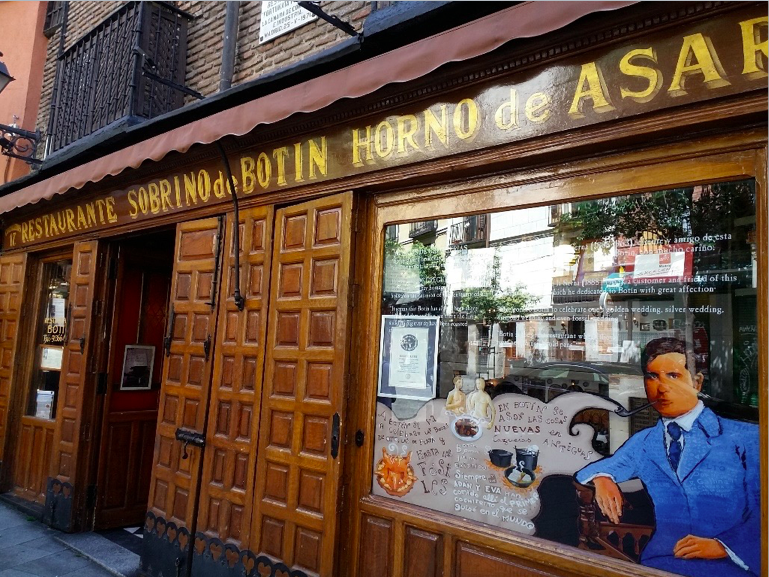An almuerzo at El Botín by: Vincenzo Reyes, September 20, 2018
I wanted to experience what Ernest Hemingway did in Spain. Eating at Restaurante Sobrino de Botín.
Here he narrates his gluttony in the form of his 1926 novel The Sun Also Rises, “We lunched upstairs at Botin´s. It is one of the best restaurants in the world. We had roast young suckling pig and drank rioja alta. Brett did not eat much. She never ate much. I ate a very big meal and drank three bottles of rioja alta.”
While my contract as an auxiliar de conversacion ended, I spent my remaining days at Madrid. And so with a click of a button, I made my reservation at El Botín. But I pondered, what makes this eatery located at 17 Calle de los Cuchilleros so famous?
Founded in 1725 by French cook Jean Botín and his wife, the Guinness Book of World Records recognizes Casa Botín as the world’s oldest and continuously operating restaurant. European royalties and American celebrities came dining in their halls. The eatery itself was immortalized by several Spanish and American literati in their works. Even the young Francisco Goya himself worked as a waiter, while awaiting his acceptance to the Royal Academy of Fine Arts.
But for a well-known place, it is hidden in a lesser-known spot.
I was looking for a culinary needle in a Madrileño haystack. I was timid to ask the locals with my “barok Spanish” and with Google Maps making me lost, I had to follow not the trail of breadcrumbs but rather the smell of cochinillo.
¡Y por fin! I found the restaurant and in a nick of time I went inside.
The restaurant’s exterior and interior retained its 18th century Castilian charm. The mellow lighting mixed well with its aura. And I could hear fire crackling from inside the horno de asar, a wood fire oven made of cast iron, in which the cocineros never extinguishes its flames. A literal allegory of Botín’s beating heart and undying passion. Then I was seated in the bodega, a wine cellar cum dining room and the restaurant’s ancient soul. I sensed and touched the brick walls surrounding me. It could’ve told me their secrets and histories. The antique wine bottles nestled inside would’ve contained the elixir of life itself.
While there were many items in Botín’s menu I wanted to try, my budget constrains me. And so I chose their menú del día. Now starts my almuerzo at the dinner table.
For my aperitivo, I was served this red, creamy, textured soup garnished with dices of green bell peppers, tomatoes and cucumbers. Once I ate a spoonful of this gazpacho andaluz, it soothed the Madrileño heat inside me. A medley of tanginess and creaminess played on the tip of my tongue. I wanted to prolong this refreshing taste by a spoonful and not by a gulp. Appreciating it even more when I dipped in freshly baked bread. And once I reached at the bowl’s bottom, the waiter whisked it away. Then I drank a glass of vino tinto to clear my palate for the next course.
Then came my plato fuerte, the main course, the star of El Botín, and most of all, the dish that Hemingway devoured and wrote about. El cochinillo asado, the Spanish sister of our Filipino lechon.
Simply, it is a plate of roasted suckling pig with three whole potatoes laced with its drippings. But I had to notice every detail of this dish. That crisp sheen of the pig’s skin contrasts with its soft, succulent flesh. Parsley, thyme and bay’s aroma emanates when I drove my knife and fork into it. Those three roasted whole potatoes absorb the cochinillo’s essence in which I cut myself a piece. When I ate pieces of this dish, three things came into my mind which makes this cochinillo asado different from the other cochinillo asados. First, the marinade mixed with the Segovian flavour inbred in the suckling makes the dish so simple yet succulent. Second, the usage of the horno de asar for roasting gives a different dimension to the dish. Not only does it infuse a smoky flavour from the holm oak wood, creates the balanced crispiness of the skin, or tenderizes the meat but that horno imbues the spirit of its 300 year old aroma in each and every suckling served. Lastly, El Botín’s cochinillo asado is an anathema to culinary sophistication and overcomplicated designs in food. It is a timeless testament that food should not only be satisfying and enjoyed but must evoke joyous memory and experience. It is a living cultural heritage of traditional Castillian cuisine.
Lastly for my postre, I ate a simple helado de vainilla drowned in chocolate sauce. A sweet ending to my almuerzo at Restaurante Sobrino de Botín.
I savoured every bite, chew, sip then washed it with wine. For that meal was the only souvenir I could never bring home or replicate it by cooking. But it is treasured in my memory and gut. As I left El Botín, I reflected that I didn’t only have an almuerzo there, it was a serendipitous ending and my last supper to my sojourn in Spain.
And as the Spanish would say when a person has enjoyed their meal, “¡Estoy satisfecho!”














